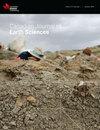墨西哥索诺拉东北部Cananea和Nacozari地区侏罗纪岩浆岩的U-Pb年代学和地球化学:侏罗纪大陆弧最南缘的时间和组成
IF 1.6
4区 地球科学
Q3 GEOSCIENCES, MULTIDISCIPLINARY
引用次数: 0
摘要
在墨西哥索诺拉东北部的Cananea和Nacozari之间的地区,北美科迪勒拉西南部侏罗纪大陆弧的火成岩。同生火成岩产于纳扎斯裂谷省较南的地区;然而,它们的构造亲和性在科迪勒拉弧的南伸展和泛大陆分裂期间与减压地幔融化有关的起源之间存在争议。我们认为所研究的岩石代表了侏罗纪大陆弧的最南端。根据地质、U-Pb锆石年代学和地球化学组成,划分出4个岩浆单元。其中布宜诺斯艾利斯花岗岩年龄为183.8±1.1 Ma,马比花岗岩年龄为175.5±1.8、173.5±1.8和171.7±1.0 Ma, Elenita组火山岩年龄为169.7±1.7 Ma, Cerro Blanco花岗岩年龄为162.3±2.4 Ma。所研究的样品对应于高度分化的岩石,高硅含量(69-76 wt.%),低Mg值(大部分为45),碱钙和过铝组成表明地壳污染。具有Eu负异常的lree富正态化斜坡和发育良好的Nb-Ta、P和Ti负异常的多元素地块为大陆弧性质提供了明确的信号。在纳扎斯省,侏罗纪岩浆活动由分散的火山碎屑岩序列组成,沉积在伸展盆地中,没有深部岩石的证据,与之相反,亚利桑那州和索诺拉北部的侏罗纪大陆弧形成了一个区域连贯的地质特征,其特征是大量暴露的火山和深部岩石。本文章由计算机程序翻译,如有差异,请以英文原文为准。
U–Pb zircon geochronology and geochemistry of the Jurassic magmatic rocks from the region of Cananea and Nacozari, northeastern Sonora, Mexico: timing and composition of the southernmost edge of the Jurassic continental arc
Igneous rocks of the Jurassic continental arc of southwest North American Cordillera crop out in the region between Cananea and Nacozari, in northeastern Sonora, Mexico. Contemporaneous igneous rocks occur farther south in the Nazas rift province; however, their tectonic affinity is debated between the southern extension of the Cordilleran arc and an origin associated with decompressive mantle melting during the Pangea breakup. We consider that the studied rocks represent the southernmost expression of the Jurassic continental arc. Four magmatic units are distinguished based on geology, U–Pb zircon geochronology, and geochemical composition. They comprise the Buenos Aires granite dated at 183.8 ± 1.1 Ma, the Mababi granite with ages of 175.5 ± 1.8, 173.5 ± 1.8, and 171.7 ± 1.0 Ma, the Elenita Formation volcanic rocks dated at 169.7 ± 1.7 Ma, and the Cerro Blanco granite dated at 162.3 ± 2.4 Ma. The studied samples correspond to highly differentiated rocks with high-silica contents (69–76 wt.%), low Mg# values (mostly <45), and alkali–calcic and peraluminous compositions suggesting crustal contamination. LREE-enriched normalized slopes with negative Eu anomalies and multielement plots characterized by well-developed negative anomalies of Nb–Ta, P, and Ti provide an unequivocal signal of the continental arc nature. In contrast to the Nazas province, where the Jurassic magmatism consists of discreet volcaniclastic sequences deposited in extensional basins with no evidence of plutonic rocks, the Jurassic continental arc of Arizona and northern Sonora forms a regionally coherent geological feature characterized by large exposures of volcanic and plutonic rocks.
求助全文
通过发布文献求助,成功后即可免费获取论文全文。
去求助
来源期刊

Canadian Journal of Earth Sciences
地学-地球科学综合
CiteScore
2.80
自引率
7.10%
发文量
66
审稿时长
6-12 weeks
期刊介绍:
The Canadian Journal of Earth Sciences reports current research in climate and environmental geoscience; geoarchaeology and forensic geoscience; geochronology and geochemistry; geophysics; GIS and geomatics; hydrology; mineralogy and petrology; mining and engineering geology; ore deposits and economic geology; paleontology, petroleum geology and basin analysis; physical geography and Quaternary geoscience; planetary geoscience; sedimentology and stratigraphy; soil sciences; and structural geology and tectonics. It also publishes special issues that focus on information and studies about a particular segment of earth sciences.
 求助内容:
求助内容: 应助结果提醒方式:
应助结果提醒方式:


